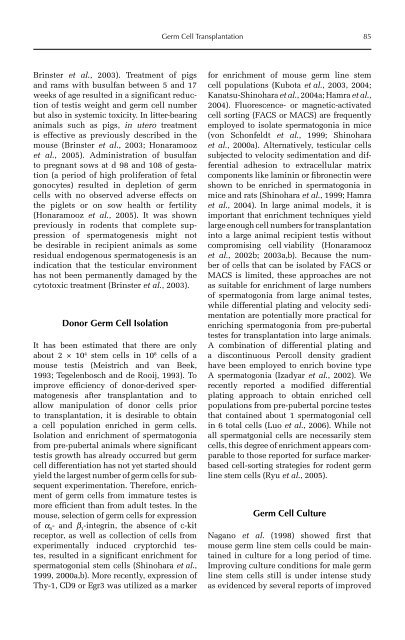Redesigning Animal Agriculture
Redesigning Animal Agriculture
Redesigning Animal Agriculture
Create successful ePaper yourself
Turn your PDF publications into a flip-book with our unique Google optimized e-Paper software.
Brinster et al., 2003). Treatment of pigs<br />
and rams with busulfan between 5 and 17<br />
weeks of age resulted in a significant reduction<br />
of testis weight and germ cell number<br />
but also in systemic toxicity. In litter-bearing<br />
animals such as pigs, in utero treatment<br />
is effective as previously described in the<br />
mouse (Brinster et al., 2003; Honaramooz<br />
et al., 2005). Administration of busulfan<br />
to pregnant sows at d 98 and 108 of gestation<br />
(a period of high proliferation of fetal<br />
gonocytes) resulted in depletion of germ<br />
cells with no observed adverse effects on<br />
the piglets or on sow health or fertility<br />
(Honaramooz et al., 2005). It was shown<br />
previously in rodents that complete suppression<br />
of spermatogenesis might not<br />
be desirable in recipient animals as some<br />
residual endogenous spermatogenesis is an<br />
indication that the testicular environment<br />
has not been permanently damaged by the<br />
cytotoxic treatment (Brinster et al., 2003).<br />
Donor Germ Cell Isolation<br />
It has been estimated that there are only<br />
about 2 × 10 4 stem cells in 10 8 cells of a<br />
mouse testis (Meistrich and van Beek,<br />
1993; Tegelenbosch and de Rooij, 1993). To<br />
improve efficiency of donor-derived spermatogenesis<br />
after transplantation and to<br />
allow manipulation of donor cells prior<br />
to transplantation, it is desirable to obtain<br />
a cell population enriched in germ cells.<br />
Isolation and enrichment of spermatogonia<br />
from pre-pubertal animals where significant<br />
testis growth has already occurred but germ<br />
cell differentiation has not yet started should<br />
yield the largest number of germ cells for subsequent<br />
experimentation. Therefore, enrichment<br />
of germ cells from immature testes is<br />
more efficient than from adult testes. In the<br />
mouse, selection of germ cells for expression<br />
of a 6- and b 1-integrin, the absence of c-kit<br />
receptor, as well as collection of cells from<br />
experimentally induced cryptorchid testes,<br />
resulted in a significant enrichment for<br />
spermatogonial stem cells (Shinohara et al.,<br />
1999, 2000a,b). More recently, expression of<br />
Thy-1, CD9 or Egr3 was utilized as a marker<br />
Germ Cell Transplantation 85<br />
for enrichment of mouse germ line stem<br />
cell populations (Kubota et al., 2003, 2004;<br />
Kanatsu-Shinohara et al., 2004a; Hamra et al.,<br />
2004). Fluorescence- or magnetic-activated<br />
cell sorting (FACS or MACS) are frequently<br />
employed to isolate spermatogonia in mice<br />
(von Schonfeldt et al., 1999; Shinohara<br />
et al., 2000a). Alternatively, testicular cells<br />
subjected to velocity sedimentation and differential<br />
adhesion to extracellular matrix<br />
components like laminin or fibronectin were<br />
shown to be enriched in spermatogonia in<br />
mice and rats (Shinohara et al., 1999; Hamra<br />
et al., 2004). In large animal models, it is<br />
important that enrichment techniques yield<br />
large enough cell numbers for transplantation<br />
into a large animal recipient testis without<br />
compromising cell viability (Honaramooz<br />
et al., 2002b; 2003a,b). Because the number<br />
of cells that can be isolated by FACS or<br />
MACS is limited, these approaches are not<br />
as suitable for enrichment of large numbers<br />
of spermatogonia from large animal testes,<br />
while differential plating and velocity sedimentation<br />
are potentially more practical for<br />
enriching spermatogonia from pre-pubertal<br />
testes for transplantation into large animals.<br />
A combination of differential plating and<br />
a discontinuous Percoll density gradient<br />
have been employed to enrich bovine type<br />
A spermatogonia (Izadyar et al., 2002). We<br />
recently reported a modified differential<br />
plating approach to obtain enriched cell<br />
populations from pre-pubertal porcine testes<br />
that contained about 1 spermatogonial cell<br />
in 6 total cells (Luo et al., 2006). While not<br />
all spermatgonial cells are necessarily stem<br />
cells, this degree of enrichment appears comparable<br />
to those reported for surface markerbased<br />
cell-sorting strategies for rodent germ<br />
line stem cells (Ryu et al., 2005).<br />
Germ Cell Culture<br />
Nagano et al. (1998) showed first that<br />
mouse germ line stem cells could be maintained<br />
in culture for a long period of time.<br />
Improving culture conditions for male germ<br />
line stem cells still is under intense study<br />
as evidenced by several reports of improved










